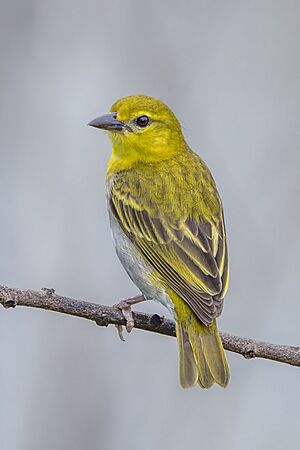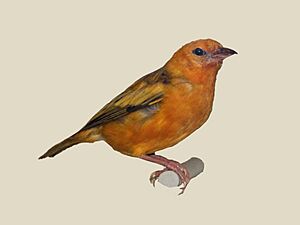Orange weaver facts for kids
Quick facts for kids Orange weaver |
|
|---|---|
 |
|
| Male | |
 |
|
| Female both P. a. aurantius in Ghana |
|
| Conservation status | |
| Scientific classification | |
| Synonyms | |
|
The orange weaver (Ploceus aurantius) is a colorful bird from the weaver family. These birds live in the tropical rainforests of Africa. They are found in different parts of western and central Africa.
Contents
What is an Orange Weaver?
The orange weaver is a small bird, growing to about 12.5 centimeters long. This measurement includes its tail. These birds look different depending on their sex and the time of year.
How to Spot an Orange Weaver
Male orange weavers are very bright during breeding season. They have a black beak and a small black patch around their eyes. Their wings are brown, but the rest of their body is a brilliant red or orange. Their eyes can be reddish-brown or pale grey.
Outside of breeding season, the males look much duller. They become mostly brown with some dark stripes. Their belly turns a creamy color. Females look like these off-season males all year round.
Sometimes, people confuse male orange weavers with another bird, the southern red bishop. However, the southern red bishop has a black belly, which helps tell them apart.
Where Do Orange Weavers Live?
Orange weavers live in western and central Africa. They prefer places with lots of water and plants. You can find them in mangrove forests and thick bushes. They also live in swamps near coastal areas. They like to be close to large rivers in West Africa.
Orange Weaver Behavior and Life Cycle
Orange weavers are social birds. They often live in groups, sometimes with hundreds of nests in one spot. They build their homes in reed beds, palms, and other trees. These birds are known for their amazing, complex nests.
What Do Orange Weavers Eat?
These birds mainly eat fruit and seeds. They also enjoy eating insects. Their diet includes locusts, beetles, and caterpillars. You usually see them in pairs or small groups looking for food.
Reproduction and Nests
Male orange weavers are polygamous. This means one male will mate with two or three females. They build oval-shaped nests using grass and strips of palm leaves. Females lay two eggs inside these nests. They then sit on the eggs to keep them warm until they hatch.
Keeping Orange Weavers as Pets
Orange weavers are sometimes kept as pets. They are quite strong for small birds. Like most finches, they should be kept in groups. They need a large space to fly around because they are very active.
Housing and Diet for Pet Weavers
You can house orange weavers with other, larger finches. They usually get along well. However, during breeding season, some males can become aggressive. If this happens, they might need to be separated from the group.
Pet orange weavers need a balanced diet. This includes small cereal seeds and fresh green plants. They also need some live food, like mealworms.



